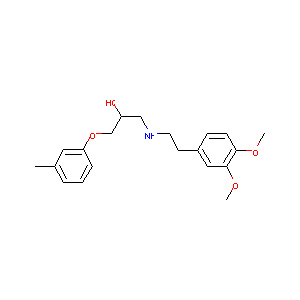Details of the Drug
General Information of Drug (ID: DMZFICR)
| Drug Name |
Bevantolol
|
||||||||||||||||||||||
|---|---|---|---|---|---|---|---|---|---|---|---|---|---|---|---|---|---|---|---|---|---|---|---|
| Synonyms |
Bevantololum; Bevantolol [INN:BAN]; Bevantololum [INN-Latin]; (+-)-bevantolol; 1-((2-(3,4-Dimethoxyphenyl)ethyl)amino)-3-(3-methylphenoxy)-2-propanol; 1-((2-(3,4-dimethoxyphenyl)ethyl)amino)-3-(3-methylphenoxy)-2-propanol; 1-(3,4-Dimethoxyphenethylamino)-3-(m-tolyloxy)-2-propanol; 1-(3,4-dimethoxyphenethylamino)-3-m-tolyloxy-propan-2-ol; 1-[2-(3,4-Dimethoxy-phenyl)-ethylamino]-3-m-tolyloxy-propan-2-ol; 1-[2-(3,4-dimethoxyphenyl)ethylamino]-3-(3-methylphenoxy)propan-2-ol; 1-{[2-(3,4-dimethoxyphenyl)ethyl]amino}-3-(3-methylphenoxy)propan-2-ol
|
||||||||||||||||||||||
| Indication |
|
||||||||||||||||||||||
| Therapeutic Class |
Antihypertensive Agents
|
||||||||||||||||||||||
| Drug Type |
Small molecular drug
|
||||||||||||||||||||||
| Structure |
 |
||||||||||||||||||||||
| 3D MOL | 2D MOL | ||||||||||||||||||||||
| #Ro5 Violations (Lipinski): 0 | Molecular Weight (mw) | 345.4 | |||||||||||||||||||||
| Logarithm of the Partition Coefficient (xlogp) | 3 | ||||||||||||||||||||||
| Rotatable Bond Count (rotbonds) | 10 | ||||||||||||||||||||||
| Hydrogen Bond Donor Count (hbonddonor) | 2 | ||||||||||||||||||||||
| Hydrogen Bond Acceptor Count (hbondacc) | 5 | ||||||||||||||||||||||
| ADMET Property |
|
||||||||||||||||||||||
| Chemical Identifiers |
|
||||||||||||||||||||||
| Cross-matching ID | |||||||||||||||||||||||
Molecular Interaction Atlas of This Drug
 Drug Therapeutic Target (DTT) |
|
||||||||||||||||||||||||||
|---|---|---|---|---|---|---|---|---|---|---|---|---|---|---|---|---|---|---|---|---|---|---|---|---|---|---|---|
 Drug-Metabolizing Enzyme (DME) |
|
||||||||||||||||||||||||||
| Molecular Interaction Atlas (MIA) | |||||||||||||||||||||||||||
Molecular Expression Atlas of This Drug
| The Studied Disease | Hypertension | |||||||||||||||||||||||||||||
|---|---|---|---|---|---|---|---|---|---|---|---|---|---|---|---|---|---|---|---|---|---|---|---|---|---|---|---|---|---|---|
| ICD Disease Classification | BA00-BA04 | |||||||||||||||||||||||||||||
|
||||||||||||||||||||||||||||||
| Molecular Expression Atlas (MEA) | ||||||||||||||||||||||||||||||
References
